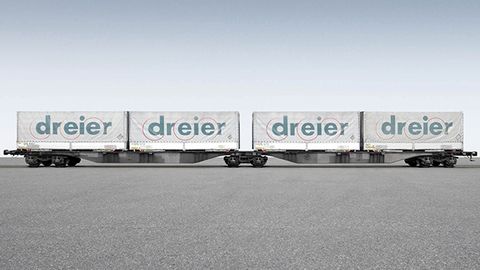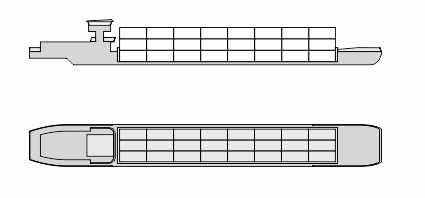Verkehrsmittel (en)
General
Means of Transport
Means of transport such as truck, train or barge represent the medium of transport used for moving cargo in containers and the like. In CT, different means of transport are used on different transport sections: freight trains and barges in the main leg as well as trucks in the pre- and post-haulage. CT combines the strengths of the individual modes of transport.
Mode of Transport
The mode of transport is the infrastructure on which the means of transport moves, i.e. rail, road, waterway and air. Accordingly, the mode of transport “rail” represents the infrastructure for the mode of transport freight train. In logistics, the terms means of transport and modes of transport are often used synonymously.
Truck
In CT, trucks are used for first and last leg, transporting the loading unit from the shipper (consignor) to the transshipment terminal (source terminal) or from the transshipment terminal (destination terminal) to the consignee. Due to their flexibility, trucks are used in CT for point-to-point delivery in the local and regional area at the beginning or end of the transport chain. For CT trucks in Germany , the maximum total weight is 44t instead of 40t as in pure road freight transport.
So-called container chassis are used for transporting the containers. In CT, semi-trailers with superstructures (trailers) can also serve as loading units themselves. Semi-trailers are used in continental traffic and handled with vertical or horizontal systems.
Container chassis

Semi trailer with tarpaulin structure

Railway
Freight trains are used for rail-bound CT transport. The maximum transport capacity of freight trains in Germany is 96 TEU. Depending on the load, freight trains reach a maximum speed of 100-120 km/h1. In general, freight trains can be divided into freight wagons and locomotives.
Traction
The locomotive (also traction vehicle) is used for traction, i.e. the transport of goods. Locomotives are owned by railway undertakings (RUs), which are national or international players in CT.
Since the majority of the rail network in Germany is electrified, electric locomotives are used for traction. Diesel locomotives, on the other hand, are used in transshipment terminals, since overhead lines cannot be installed in terminals due to crane systems.
E-Lok

Diesel-Lok

Freight Waggons

Flat Wagon
The most important wagon type in CT is the so-called flat wagon (also called container wagon). Flat wagons (classification) are freight wagons for carrying containers. Depending on the size and number of axles, flat wagons can accommodate standardized container types and swap bodies.
To accommodate containers, the flat wagon has so-called pins that fasten the containers. The corner castings of the container are placed on the pins. In order to be able to accommodate different container sizes, flat wagons also have folding pins, which can be used as required.
Pocket Wagon
Pocket wagons are special freight wagons designed to accommodate semi-trailers. For this purpose, the wagon has a so-called “pocket” which compensates for the height of the semi-trailer during transport. The semi-trailers are inserted underneath the frame so that they do not exceed the height of the maximum clearance profile. Some pocket wagons also have pins on the frame to transport containers or swap bodies, which is why they are also referred to as universal wagons.2

Barge
An alternative to freight trains in the main leg of CT is the use of barges, one of their strengths being their high loading capacity compared to other means of transport. External costs such as energy consumption, greenhouse gas emissions, traffic safety, land consumption and noise are also much lower than for rail and road3. The quality of water-bound CT is largely dependent on lock times, the geometry of the waterways, but also on water levels (precipitation, drought) and weather conditions (frost). There is still a lot of potential in using barges for CT transport.

The use of inland waterway vessels depends on the geographical, structural, technical and legal framework conditions of the waterways, including:
- Water level
- Locks and bridges
- Requirements for ship dimensions
Important European categories of ships in CT
| Schiffsklasse | Länge | Breite | Max. Tiefgang | TEU pro Lage | Max. Lagen | TEU Kapazität |
Europa Johann Welker / Europe Type
Quelle: Bieker, DST | 80 – 85 m | 9,50 m | 2,5 – 2,8 m | 24 | 2 – 3 | 48 – 72 |
GMS 1 Großmotorgüterschiff / Long Motor Vessel Type 1
Quelle: Bieker, DST | 110 m | 11,45 m | 4 m | 52 | 2 – 5 | 104 – 260 |
üGMS2 Übergroßes Großmotorgüterschiff / Extra-long Large Motor Vessel Type 3
Quelle: Bieker, DST | 135 m | 11,45 m | 4 m | 68 | 2 – 5 | 136 – 340 |
GMS1 + Leichter Europa IIb Koppelverband / Breasted-up-formation (Large Motor Vessel Type 1 + Europe IIb Lighter)
Quelle: Bieker, DST | 186,50 m | 11,4 m | 4 m | 82 | 2 – 5 | 164 – 410 |
| GMS1 + Leichter Europa IIb Koppelverband / Breasted-up-formation (Large Motor Vessel Type 1 + Europe IIb Lighter) | 186,50 m | 22,80 m | 4 m | 82 | 4 | 800 |
JOWI-Klasse Groß-Container-Motor-Schiff (GCMS) / Large Container Motor Vessel – JOWI-Class
Quelle: Bieker, DST | 135 m | 17 m | 4 m | 102 | 2 – 6 | 204 – 612 |
Schubverband 3 gliedrig, 2 spurig (Streckenschubboot mit 6 Leichtern Europa IIb) / Pushed-convoy (three-part, two-file; pusher with 6 Europe IIb lighters)
Quelle: Bieker, DST | 270 m | 22,8 m | 4 m | 180 | 2 – 3 | 360 – 540 |
Schubverband 2 gliedrig, 3 spurig (Streckenschubboot mit 6 Leichtern Europa IIb) / Pushed-convoy (two-part, three-file; pusher with 6 Europe IIb lighters)
Quelle: Bieker, DST | 193 m | 34,2 m | 4 m | 180 | 2 – 3 | 360 – 540 |
Die Anzahl der Containerlagen je Schiffsklasse entscheidet sich nach dem Wasserstand, der Stabilität des Schiffs, den geografischen Bedingungen und dem Ausbaugrad der Wasserstraße. Der Tiefgang und die Fixpunkthöhe* der Binnenschiffe variieren in Anhängigkeit mit der Beladung (Gewicht, Höhe).
___________________________________________
* Fixpunkthöhe = Höhe des Schiffs über dem Wasserspiegel
1 vgl. Bildungswerk Spedition und Logistik (2012), Der Spediteur und der Eisenbahngüterverkehr
2 vgl. TX-Logistik (2013), Doppeltaschenwagen
3 vgl. Planco Consulting GmbH (2007), Verkehrswirtschaftlicher und ökologischer Vergleich der Verkehrsträger Straße, Bahn und Wasserstraße
4 vgl. VBW – Verein für europäische Binnenschifffahrt und Wasserstraßen e.V. (2011), Eignung der Binnenwasserstraßen für den Containertransport












